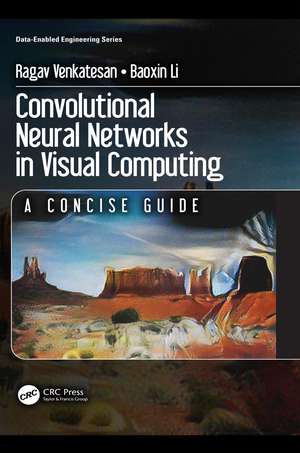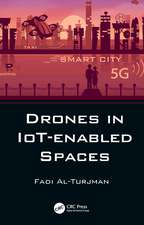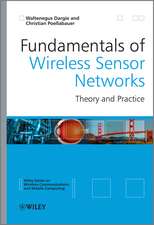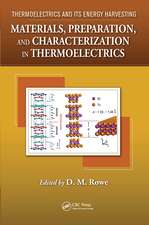Convolutional Neural Networks in Visual Computing: A Concise Guide: Data-Enabled Engineering
Autor Ragav Venkatesan, Baoxin Lien Limba Engleză Paperback – 7 sep 2017
| Toate formatele și edițiile | Preț | Express |
|---|---|---|
| Paperback (1) | 424.47 lei 6-8 săpt. | |
| CRC Press – 7 sep 2017 | 424.47 lei 6-8 săpt. | |
| Hardback (1) | 874.34 lei 6-8 săpt. | |
| CRC Press – sep 2017 | 874.34 lei 6-8 săpt. |
Preț: 424.47 lei
Preț vechi: 550.65 lei
-23% Nou
Puncte Express: 637
Preț estimativ în valută:
81.26€ • 83.62$ • 68.50£
81.26€ • 83.62$ • 68.50£
Carte tipărită la comandă
Livrare economică 01-15 martie
Preluare comenzi: 021 569.72.76
Specificații
ISBN-13: 9781138747951
ISBN-10: 1138747955
Pagini: 186
Ilustrații: 37 Line drawings, black and white; 23 Halftones, black and white; 5 Tables, black and white
Dimensiuni: 156 x 234 x 17 mm
Greutate: 0.27 kg
Ediția:1
Editura: CRC Press
Colecția CRC Press
Seria Data-Enabled Engineering
ISBN-10: 1138747955
Pagini: 186
Ilustrații: 37 Line drawings, black and white; 23 Halftones, black and white; 5 Tables, black and white
Dimensiuni: 156 x 234 x 17 mm
Greutate: 0.27 kg
Ediția:1
Editura: CRC Press
Colecția CRC Press
Seria Data-Enabled Engineering
Public țintă
Professional Practice & DevelopmentCuprins
Dedication; Acknowledgements; About the Author; Preface ; Chapter 1: Introduction to visual computing; Chapter 2: Learning as a regression problem; Chapter 3: Artificial neural networks; Chapter 4: Convolutional neural networks; Chapter 5: Modern and novel usages of CNNs; Appendix; Postscript
Notă biografică
Ragav Venkatesan is currently completing his Ph.D. study in Computer Science in the School of Computing, Informatics and Decision Systems Engineering at Arizona State University. He has been a Research Associate with the Visual Representation and Processing Group in ASU, and has worked as a Teaching Assistant for several graduate-level courses in machine learning, pattern recognition, video processing and computer vision. Prior to this, he was a Research Assistant with the Image Processing and Applications Lab in the School of Electrical & Computer Engineering at ASU, where he obtained an M.S. degree in 2012. From 2013 to 2014, Venkatesan was with the Intel Corporation as a computer vision research intern working on technologies for autonomous vehicles. Venkatesan regularly serves as a reviewer for several peer-reviewed journals and conferences in machine learning and computer vision.
Baoxin Li received his Ph.D. in electrical engineering from the University of Maryland, College Park, in 2000. He is currently a Professor and Chair of the Computer Science and Engineering program, and a Graduate Faculty in Electrical Engineering and Computer Engineering programs at Arizona State University, Tempe. From 2000 to 2004, he was a Senior Researcher with SHARP Laboratories of America, Camas, Washington, where he was a technical lead in developing SHARP’s trademarked HiMPACT Sports technologies. From 2003–2004, he was also an Adjunct Professor with the Portland State University, Oregon. He holds eighteen issued U.S. patents and his current research interests include computer vision and pattern recognition, multimedia, social computing, machine learning, and assistive technologies. He won twice the SHARP Laboratories’ President Award, in 2001 and 2004 respectively. He also won the SHARP Laboratories’ Inventor of the Year Award in 2002. He was a recipient of the National Science Foundation’s CAREER Award.
Baoxin Li received his Ph.D. in electrical engineering from the University of Maryland, College Park, in 2000. He is currently a Professor and Chair of the Computer Science and Engineering program, and a Graduate Faculty in Electrical Engineering and Computer Engineering programs at Arizona State University, Tempe. From 2000 to 2004, he was a Senior Researcher with SHARP Laboratories of America, Camas, Washington, where he was a technical lead in developing SHARP’s trademarked HiMPACT Sports technologies. From 2003–2004, he was also an Adjunct Professor with the Portland State University, Oregon. He holds eighteen issued U.S. patents and his current research interests include computer vision and pattern recognition, multimedia, social computing, machine learning, and assistive technologies. He won twice the SHARP Laboratories’ President Award, in 2001 and 2004 respectively. He also won the SHARP Laboratories’ Inventor of the Year Award in 2002. He was a recipient of the National Science Foundation’s CAREER Award.
Descriere
This book covers the fundamentals in designing and deploying techniques using deep architectures. It is intended to serve as a beginner's guide to engineers or students who want to have a quick start on learning and/or building deep learning systems.
















